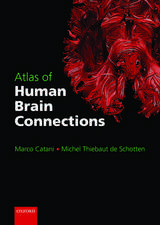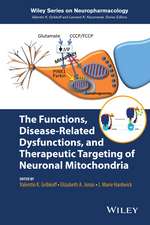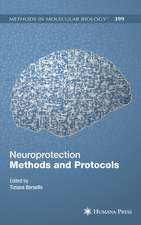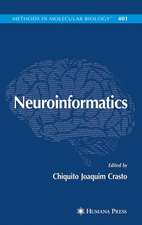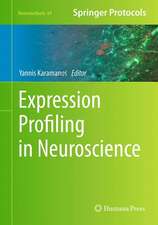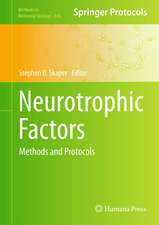The Cell Cycle in the Central Nervous System: Contemporary Neuroscience
Editat de Damir Janigroen Limba Engleză Hardback – mar 2006
| Toate formatele și edițiile | Preț | Express |
|---|---|---|
| Paperback (1) | 1236.99 lei 6-8 săpt. | |
| Humana Press Inc. – 23 aug 2016 | 1236.99 lei 6-8 săpt. | |
| Hardback (1) | 1244.71 lei 6-8 săpt. | |
| Humana Press Inc. – mar 2006 | 1244.71 lei 6-8 săpt. |
Din seria Contemporary Neuroscience
- 5%
 Preț: 1128.63 lei
Preț: 1128.63 lei - 18%
 Preț: 965.52 lei
Preț: 965.52 lei - 5%
 Preț: 1108.35 lei
Preț: 1108.35 lei - 18%
 Preț: 1228.15 lei
Preț: 1228.15 lei - 18%
 Preț: 1229.73 lei
Preț: 1229.73 lei - 18%
 Preț: 1231.64 lei
Preț: 1231.64 lei - 18%
 Preț: 945.47 lei
Preț: 945.47 lei - 18%
 Preț: 1244.08 lei
Preț: 1244.08 lei - 15%
 Preț: 638.76 lei
Preț: 638.76 lei - 18%
 Preț: 1240.47 lei
Preț: 1240.47 lei - 18%
 Preț: 1385.99 lei
Preț: 1385.99 lei - 18%
 Preț: 1227.84 lei
Preț: 1227.84 lei - 18%
 Preț: 1220.88 lei
Preț: 1220.88 lei - 18%
 Preț: 961.55 lei
Preț: 961.55 lei - 15%
 Preț: 695.70 lei
Preț: 695.70 lei - 18%
 Preț: 959.82 lei
Preț: 959.82 lei - 5%
 Preț: 1112.17 lei
Preț: 1112.17 lei - 18%
 Preț: 1233.83 lei
Preț: 1233.83 lei - 18%
 Preț: 950.96 lei
Preț: 950.96 lei - 24%
 Preț: 799.51 lei
Preț: 799.51 lei - 18%
 Preț: 954.77 lei
Preț: 954.77 lei - 18%
 Preț: 1227.21 lei
Preț: 1227.21 lei - 5%
 Preț: 1117.46 lei
Preț: 1117.46 lei - 18%
 Preț: 1248.02 lei
Preț: 1248.02 lei - 18%
 Preț: 949.10 lei
Preț: 949.10 lei - 5%
 Preț: 1114.35 lei
Preț: 1114.35 lei - 15%
 Preț: 694.22 lei
Preț: 694.22 lei - 18%
 Preț: 950.52 lei
Preț: 950.52 lei - 5%
 Preț: 1124.07 lei
Preț: 1124.07 lei - 5%
 Preț: 1117.10 lei
Preț: 1117.10 lei - 24%
 Preț: 1089.45 lei
Preț: 1089.45 lei - 18%
 Preț: 1227.52 lei
Preț: 1227.52 lei - 18%
 Preț: 955.08 lei
Preț: 955.08 lei - 5%
 Preț: 1417.38 lei
Preț: 1417.38 lei
Preț: 1244.71 lei
Preț vechi: 1517.94 lei
-18% Nou
Puncte Express: 1867
Preț estimativ în valută:
238.20€ • 258.65$ • 200.09£
238.20€ • 258.65$ • 200.09£
Carte tipărită la comandă
Livrare economică 23 aprilie-07 mai
Preluare comenzi: 021 569.72.76
Specificații
ISBN-13: 9781588295293
ISBN-10: 158829529X
Pagini: 584
Ilustrații: 584 p.
Dimensiuni: 178 x 254 x 40 mm
Greutate: 1.22 kg
Ediția:2006
Editura: Humana Press Inc.
Colecția Humana
Seria Contemporary Neuroscience
Locul publicării:Totowa, NJ, United States
ISBN-10: 158829529X
Pagini: 584
Ilustrații: 584 p.
Dimensiuni: 178 x 254 x 40 mm
Greutate: 1.22 kg
Ediția:2006
Editura: Humana Press Inc.
Colecția Humana
Seria Contemporary Neuroscience
Locul publicării:Totowa, NJ, United States
Public țintă
ResearchCuprins
Cell Cycle During the Development of the Mammalian Central Nervous System.- Methodological Considerations in the Evaluation of the Cell Cycle in the Central Nervous System.- Neural Stem Cells.- Progenitors and Precursors of Neurons and Glial Cells.- Vasculogenesis and Angiogenesis.- Neuronal Migration and Malformations of Cortical Development.- Postnatal Development of Neurons and Glia.- Genome-Wide Expression Profiling of Neurogenesis in Relation to Cell Cycle Exit.- Neurogenesis and Apoptotic Cell Death.- Ion Channels and the Cell Cycle.- Nonsynaptic GABAergic Communication and Postnatal Neurogenesis.- Critical Roles of Ca2+ and K+ Homeostasis in Apoptosis.- Mammalian Neural Stem Cell Renewal.- Control of the Cell Cycle and Apoptosis in Glia.- Methods of Determining Apoptosis in Neuro-Oncology.- Cell Cycle, Neurological Disorders, and Reactive Gliosis.- Potassium Channels, Cell Cycle, and Tumorigenesis in the Central Nervous System.- Adult Neurogenesis: A Mechanism for Brain Repair?.- Enhanced Neurogenesis Following Neurological Disease.- Endothelial Injury and Cell Cycle Re-Entry.- The Contribution of Bone Marrow-Derived Cells to Cerebrovascular Formation and Integrity.- Microvessel Remodeling in Cerebral Ischemia.- Vascular and Neuronal Effects of VEGF in the Nervous System.- Epidermal Growth Factor Receptor in the Adult Brain.- Cell Cycle Re-Entry: A Mechanism of Brain Disease?.- Neurodegeneration and Loss of Cell Cycle Control in Postmitotic Neurons.- Cell Cycle Activation and the Amyloid-? Protein in Alzheimer’s Disease.- Neuronal Precursor Proliferation and Epileptic Malformations of Cortical Development.- Vascular Differentiation and the Cell Cycle.- Adult Neurogenesis and Central Nervous System Cell Cycle Analysis.- Neurogenesis in Alzheimer’s Disease.-The Biology of Gliomas.- p53 and Multidrug Resistance Transporters in the Central Nervous System.- Signaling Modules in Glial Tumors and Implications for Molecular Therapy.- Detection of Proliferation in Gliomas by Positron Emission Tomography Imaging.- Transformation of Normal Astrocytes Into a Tumor Phenotype.- Mechanisms of Gliomagenesis.- Future Directions.- Cell Cycle of Encapsulated Cells.- Viral Vector Delivery to Dividing Cells.- Electrical Stimulation and Angiogenesis.- Developmental and Potential Therapeutic Aspects of Mammalian Neural Stem Cells.- Mammalian Sir2 Proteins.
Textul de pe ultima copertă
It is now known that the adult mammalian brain undergoes repair and renewal from pools of stem cells and that cell cycle alteration may cause a variety of neurological disorders ranging from autism to brain tumors. In The Cell Cycle in the Central Nervous System, prominent researchers, physicians, engineers, and pharmacologists join forces to delineate how the brain is a complex organ composed of widely varying cell types, including blood vessels, and what its cellular-based disorders may be. Topics covered range from the cell cycle during the prenatal development of the mammalian central nervous system (CNS) to future directions in postnatal neurogenesis through gene transfer, electrical stimulation, and stem cell introduction. Additional chapters examine the postnatal development of neurons and glia, the regulation of cell cycle in glia, and how that regulation may fail in pretumor conditions or following a nonneoplastic CNS response to injury. Highlights include treatments of the effects of deep brain stimulation on brain development and repair; the connection between the electrophysiological properties of neuroglia, cell cycle, and tumor progression; and the varied immunological responses and their regulation by cell cycle.
State-of-the-art and readily understandable, The Cell Cycle in the Central Nervous System illuminates our understanding of how brain development, disease, renewal, and repair may be mediated by vasculogenesis, neurogenesis, and the immune system, and offers an exciting variety of new research opportunities for all those investigating brain tumors, neurodevelopment, and neurological disorders.
State-of-the-art and readily understandable, The Cell Cycle in the Central Nervous System illuminates our understanding of how brain development, disease, renewal, and repair may be mediated by vasculogenesis, neurogenesis, and the immune system, and offers an exciting variety of new research opportunities for all those investigating brain tumors, neurodevelopment, and neurological disorders.
Caracteristici
Includes supplementary material: sn.pub/extras





